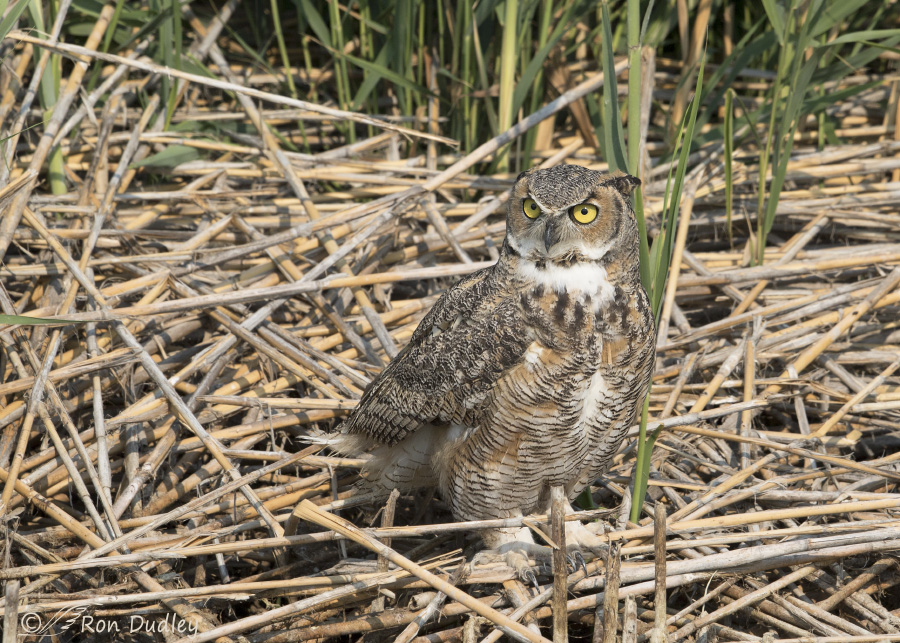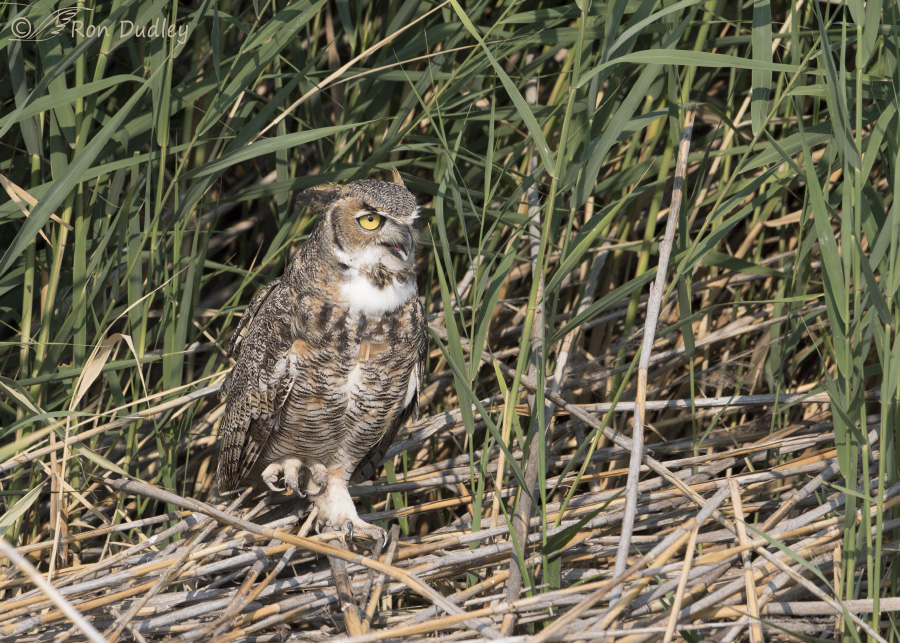Photographing birds is often a game of playing the odds. Sometimes you win and sometimes you lose.

1/2000, f/8, ISO 250, Canon 7D Mark II, Canon EF 500mm f/4L IS II US, not baited, set up or called in
I photographed this adult Great Horned Owl just over three weeks ago near the edge of a canal at Bear River Migratory Bird Refuge (I posted three images of this bird previously but these two are new to my blog). I believe it was hunting during the day (unusual for the species) but in this habitat I’m not sure what its intended prey might have been. It was often near the water’s edge so perhaps it was laying in wait for an unsuspecting bird to come swimming down the canal – they’re known to occasionally take large birds like ducks, geese and herons.

1/2000, f/7.1, ISO 250, Canon 7D Mark II, Canon EF 500mm f/4L IS II US, not baited, set up or called in
The owl was obviously hot. It was often panting (gular fluttering) as it’s doing here but it still spent much of the time near the water instead of buried more deeply in the cooler shade of the phragmites. Here I like the good look at those impressive talons on the raised right foot.
In 46 minutes I took many hundreds of images of this owl but I had to make a decision about my strategy – do I leave the teleconverter on for excellent closeup detail or take it off to give me enough room to keep the entire bird in the frame if/when it took off? One option would be to do both but I’ve learned from experience that in the 5+ seconds it takes me to swap out the converter my subject seems to always choose that moment to take off and I miss the shots.
In all my years of photographing Great Horned Owls I still don’t have a single decent image of one in flight so I opted for the flight shots and left my teleconverter off for almost the entire time I spent with the bird. But the owl only took off once and flew a short distance and of course those shots didn’t turn out. After 46 minutes with my lens trained on the bird my shooting eye became strained and squinty and I became a little twitchy myself so eventually I gave up, left the bird in place and drove down the road looking for other birds.
The end result? I only have about a half-dozen nicely detailed images taken with the teleconverter attached and I have far too many shots of the owl that are nice but they could have been better, especially for the purposes of making large prints or publishing. I gambled and lost.
Made me think of an old favorite song of mine, “The Gambler“, by Kenny Rogers.
- You’ve got to know when to hold ’em
Know when to fold ’em
Know when to walk away
And know when to run
I should have folded and left my tc attached.
Ron


But these shots are so beautiful! It’s such an unusual setting. I love them.
Yes, it is an unusual setting for the species, Sharon. I’ve never photographed and rarely seen GHO’s in a marsh before.
I like the images as they are Ron. Sometimes I like to see a “wildlife in landscape” versus a tighter frame on only the wildlife. The waiting and waiting for the owls to fly is indeed a real pain. It is almost as if they are watching us and playing with us. Probably so
I like them too, Ed. I just wish the ratio of “bird in habitat” shots to close-ups wasn’t about 100 to 1…
I am quite sure that the malevolent photo subjects KNOW what we are doing. Sometimes better than us. At least your errors are made on animate objects.
Somedays a flower outsmarts me…
And, as a PS, loved the owl. Of course.
“Somedays a flower outsmarts me”
You made me smile again, EC.
Always amazed at the feather detail. Ain’t nature grand? Thanks for all your photos.
It surely is, Sarah.
Great shots anyway Ron!
Charlotte
Thanks, Charlotte.
How about seeing the perfect shot of a long-soughtcafter subject in an ideal pose and tealizing, too late, that you left the effing lens cap on….Any way, you captured some interesting, if odd, behavior…and any pictute of a GHO is a good one for me….
I see the evil iPad is still doing its thing…I CHECKED for spelling and as soon as I hit “send”, it changes things….I HATE IT!!!
If there’s a mistake to be made I’ve made it, Patty – including the lens cap thing.
Patty, my husband does that with great regularity with his video camera, especially since the latest one requires that it be opened manually and the old one didn’t (but he still had problems with finding out it wasn’t on after he finished shooting)…
Nice shots even if you didn’t get the one you wanted! That is the way it goes with birds and other wildlife it seems. Zaphir has it right on!
Zaphir has it right on! 
Yup, Zaphir hit the nail squarely on the head.
I know about eye strain and shoulder strain and carpel tunnel strain holding that monster lens. Stared at a Swainson fledgeling on a post for an hour and a half. He was perfectly content preening and grooming soaking up sun totally unsympathetic to my plight. …… I had to give up. Any suggestions for a bean bag or window mount. ?????
“Any suggestions for a bean bag or window mount?”
Absolutely. IMO a “noodle” is the best way to go!
https://www.featheredphotography.com/blog/2014/09/24/tips-tricks-and-strategies-for-using-your-vehicle-as-a-mobile-blind/
I second the “Noodle” motion
I like seeing the close-ups of these gorgeous birds. Hopefully you’ll have more opportunities to get flight shots.
I hope so, Susan. GHO flight shots continue to elude me so I’ve become a bit of a fanatic about getting them.
Ah yes you made me smile, chuckle with “You’ve got to know when to hold ’em” and the rest, OH, so true!! Love that song!!
It makes me feel better when I realize I’m not the only one to forget to put the right lens on for the right conditions, reset my settings, etc., etc.
But, even so, I still do stupid things only to realize it after the fact!!
Life and photography are a constant learning process – but like some of my students, I wonder if I ever will catch on!! VBG!
Thanks for sharing.
Dick, I knew if I referenced that song (especially if I watched the video) I’d have the earworm for the rest of the day. But IMO if you’re going to have an earworm this is a good one to have.
Ron – I share your fear of swapping gear while on a perched bird…99% of birds know it means you’ll miss the shot and they take advantage of that. You can toss in there: Looking at your settings, looking around for other birds, looking at your watch or phone, or even glancing around to make sure you’re not in traffic’s way. They know and they bolt. 49 perched shots and 1 butt shot as it chuckles and flies away.
Great owl shot and amusing story to go with it. You’ll get em’ next time
You said it all better than I did, Zaphir. I think Murphy’s law originated with bird photography!